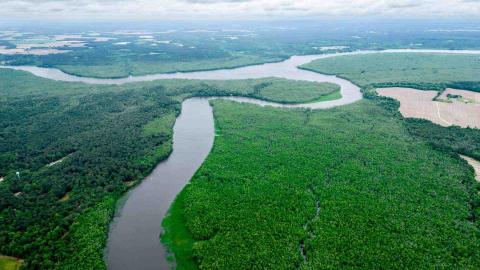At first glance, it’s a simple photograph of a man resting: Andrew Baldwin stands at the water’s edge surrounded by tall, bare trees and spindly undergrowth that bursts with spring-green leaves. He leans in his brown muck boot suspenders against a thick tree trunk.
But linger over the photo and notice that Baldwin appears weighed down in thought, his expression troubled, his hand tense and crimped by his side. The fleeting moment captures a scientist coming to grips with the destruction of a unique and wild forest.
The image of Baldwin, a wetland ecologist with the University of Maryland’s Department of Environmental Science and Technology (ENST), is featured in an exhibition at nearby Joe’s Movement Emporium that aims to raise awareness of the beauty and fragility of tidal ash forests—wild, inaccessible wetland ecosystems that are being destroyed by a tiny invasive beetle called the emerald ash borer.
“The Ash Forest Project” is the co-creation of photographer Leslie Brice, who is assistant director of UMD’s National Scholarships Office, and science journalist Gabriel Popkin. To capture drone imagery for the exhibit, the team worked with ENST major Yazan Aboushi ’22, a licensed drone pilot who has won awards for his environmental documentaries.

“When this photo was taken, we hadn’t been to that site since the year before, and this was the first time we saw signs of ash borer,” said Baldwin, whose team is documenting the ecological changes resulting from ash borer infestations to preserve and possibly to restore the forests. “We could see the trees dying back and the canopy really opening up. I remember thinking, ‘Wow, this has really happened fast.’ I was sort of taken aback by it, and I guess I was just processing all that.”
Tidal wetland ash forests are strange and wondrous places. Submerged by freshwater twice a day, each tree supports a hummock of life at its base, a small island above the tide line. The inaccessibility of these drenched ecosystems has protected them from development, and they have remained largely unexplored oases in the heavily populated mid-Atlantic.
Some of Brice’s photos evoke the wonder of these forests, including an image of an insect perched on a leaf, its thin crimson body glittering between two deep green iridescent wings like a flash of Christmas bling. This is the paradoxically beautiful ash borer at the center of all the destruction.
“Two critical elements of photography are light and patience,” Brice said. “I have very little patience in general, but being in these wetlands, watching and waiting while the scientists took their measurements, has opened me up to a quiet observation that has helped me grow as a photographer.”

Brice said the project, her first foray into science and nature photography, has also brought her a new awareness of her role in protecting the environment. “I try to be a good steward of my little space in the world, but I feel a much stronger sense of gratitude and awe, and a tremendous sense of responsibility that I didn't really fully understand before,” Brice said.
The collaboration brought a new perspective to Baldwin as well.
“As scientists, we’re documenting what’s happening, and it can seem sort of dry, and all about the data,” he said, “but when I see this whole effort that Leslie and Gabe did, I see this human, emotional side of it. You know we don’t always step back and take a moment to look at where we are, and think about the forest this way.”

